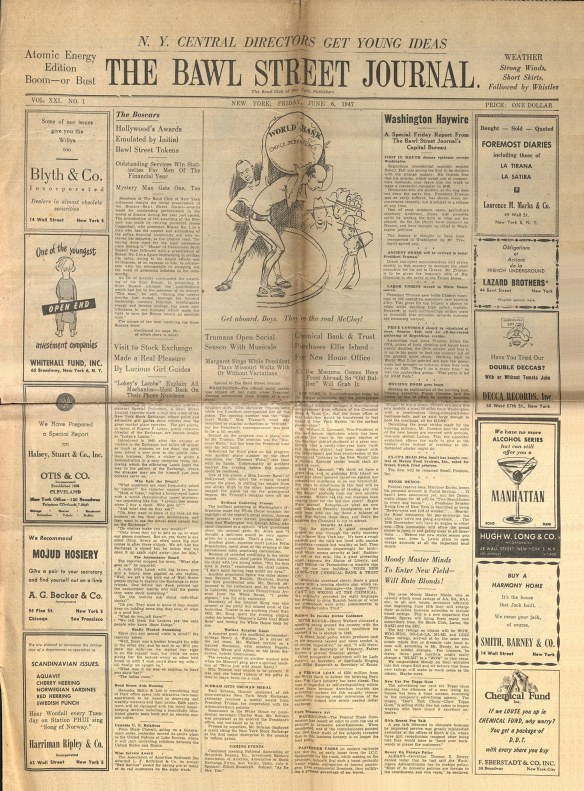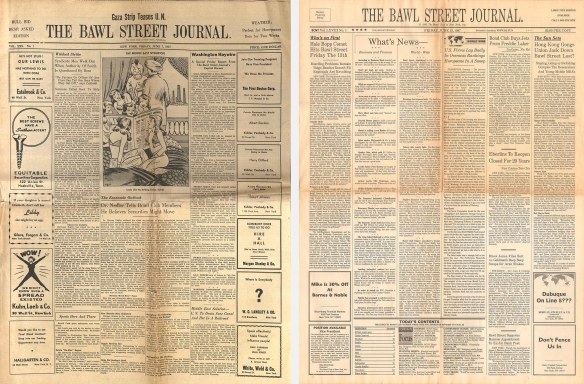Parody Of: The Wall Street Journal. Title: “The Bawl Street Journal.”
By: The Bond Club of New York. Dates: June 1919 – June 2009.
Availability: Findable on eBay, ABEbooks, etc.; 1930s-’80s issues most common.
This was going to be a salute to “The Bawl Street Journal” on the hundredth birthday of its sponsor, the Bond Club of New York, but instead it’s a eulogy. On June 17, 2017, a message appeared on www.thebondclub.com saying the group’s centennial celebration three days earlier may have been its “Last Hurrah.” According to “Bailing Out the Bond Club,” the group was still $14,000 in debt from its previous big bash in 2015, despite several fundraising efforts. Worse, it had “no current members to help generate revenue.”
Generating revenue was once the Club’s strong suit. It was started in June 1917 by a group of young Wall Streeters who had been asked to help the Treasury Department sell Liberty Bonds in World War I. Sell they did: The four Liberty Loan drives of 1917-18 netted over $17 billion ($6.3 trillion today), or roughly two-thirds of U.S. war spending. Finding they enjoyed each other’s company, the salesmen kept the club going after the Armistice as an outlet for shop-talk and story-swapping. In 1919, a member named Robert Bould had the bright idea to preserve some of this camaraderie in a parody of The Wall Street Journal.
Bould’s mix of political satire and inside jokes proved a hit, and “The Bawl Street Journal” became a profitable annual tradition. Brokerage houses and other pillars of finance ran ads mocking themselves and their customers. In 1921, the Club spent profits from the third issue on a day of fun and frivolity at the Sleepy Hollow Country Club in Tarrytown, N.Y. That caught on, too, and in 1934 the parody and party were written up in Time:
Only tip-top Manhattan bondmen enjoy the Sleepy Hollow jamboree, but the Bond Club’s annual publication – the “Bawl Street Journal” – is sold in every important financial city in the land and is even ordered from Europe, China, Brazil. Written largely by bankers, brokers and their employees and printed on the presses of its famed prototype, the Wall Street Journal, the “Bawl Street Journal” is regarded as the most expert parody in the publishing field.
Founder Robert A. Bould began having fun with the sedate Wall Street Journal and its advertisers in 1919, but after he was drowned in Long Island Sound in 1926 publication lapsed for five years. In 1931 the “Bawl Street Journal” was resurrected by John A. Straley, lean, sardonic promotion manager for Corporate Equities, Inc. A writer of fiction on the side, Editor Straley started offering prizes which brought in contributions from all over the U.S. This year more than 10,000 copies were sold at 50¢ each…. (Time, June 4, 1934)
Straley stayed with the “BSJ” through 1962, except for a four-year gap during World War II, putting in two months unpaid work on every eight- to twelve-page issue. Circulation reached 44,000 in 1957 and topped 60,000 in 1964, selling for $1 a copy when the real Journal cost only a dime. A switch to online publication in 2005 wiped out that source of income, though printed copies were still distributed at the annual field day.
Like its prototype, the “BSJ” favored old-fashioned layout and robber-baron politics. Deficit spenders and government regulators were constant targets, especially when Democrats held the White House. The 1936 edition reported that Treasury Secretary Henry Morgenthau planned to balance the federal budget by having the government pay 50 percent income tax on its own income. “True, … an unscrupulous government might find ways to avoid paying taxes to itself,” the Secretary was quoted as saying, “but I expect to watch myself very closely.” A similar story in 2009 had former Illinois Governor (and convicted bribe-taker) Rod Blagojevich offering to hold funds from the Obama administration’s Troubled Asset Relief Program in either “carefully selected financial institutions or in the trunk of …. [his] 1992 Chevrolet Impala.”
Contributors took a kinder view of their own foibles: “Without resorting to an overactive use of ribaldry, we have attempted to humorize the Street, its characters and its conditions,” the Publications Committee wrote in the 1947 edition. Much of that humor involved groan-worthy puns on members’ names and cracks about their golf games, hairlines and other personal matters. The “BSJ” also catered to its mostly male audience with gag cartoons of the wolfish-boss-and-sexy-secretary variety, which remained a staple long after they vanished from other upscale publications. Many were commissioned by brokerage firms and run as paid ads, sometimes with the names of real Wall Streeters attached to the characters.
Most victims took the “Journal’s” ribbing in good humor — or pretended to — but jibes at real people and businesses led to trouble in the 21st Century. The fatal blow came when the feds stiffened so-called “compliance” rules after the 9/11 attacks and 2008 Recession. Mainly intended to stop money laundering and insider trading, the new rules also cracked down on traders who spread rumors that might affect stock and bond prices. According to “Bailing Out the Bond Club,” many firms decided to play it safe by canceling ads and warning staffers not to submit “disparaging remarks about other firms and employees” — which was the whole point of this annual roast-in-print.
Does “The Bawl Street Journal” still exist? The only edition posted on the Bond Club’s website is Vol. LXXVIII, No. 1,* from 2009, and a recent Google search turned up nothing more recent. Still, 90 years is a long time to spend parodying a single publication; the only comparable run I can think of is the Harvard Lampoon’s war on The Crimson, which began in 1901 and is still in progress. “B.S.J.,” R.I.P. – VCR
________________________________
* To my knowledge, no Vol. ever had a No. 2.




